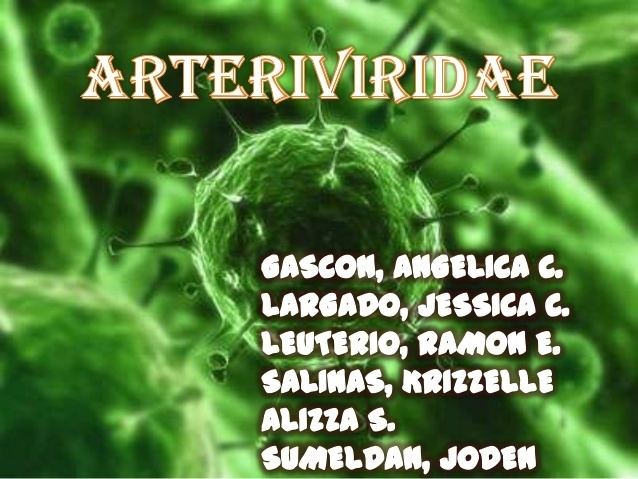Group Group IV ((+)ssRNA) Family Arteriviridae Higher classification Arteriviridae | Order Nidovirales Scientific name Arterivirus Rank Genus | |
 | ||
Lower classifications Porcine reproductive and respi, Lactate dehydrogenase elevating, Simian hemorrhagic fever virus | ||
Dr michael veit processing of gp5 and gp3 of arteriviruses
Arterivirus is the only genus of viruses in the family Arteriviridae, which is within the order Nidovirales. Vertebrates serve as natural hosts. There are currently four species in this genus including the type species Equine arteritis virus. Diseases associated with this genus include: EAV: vascular lesions, fever, edema, abortion. PRRSV: abortions and respiratory disease. SHFV: fever, edema, dehydration, hemorragies, death (almost 100%).
Contents
- Dr michael veit processing of gp5 and gp3 of arteriviruses
- Taxonomy
- Structure
- Life Cycle
- History
- Reorganisation
- References
Taxonomy
Group: ssRNA(+)
Structure
Viruses in Arterivirus are enveloped, with spherical, Round, and Isometric geometries. The diameter is around 45-60 nm. Genomes are linear and non-segmented, around 12-16kb in length.
Life Cycle
Viral replication is cytoplasmic. Entry into the host cell is achieved by attachment to host receptors, which mediates clathrin-mediated endocytosis. Replication follows the positive stranded RNA virus replication model. Positive stranded rna virus transcription is the method of transcription. Translation takes place by leaky scanning, and -1 ribosomal frameshifting. Vertebrates serve as the natural host. Transmission routes are transplancental, contact, urine, semen, air borne particles, and saliva.
History
In 1996, the family Arteriviridae was included within the order Nidovirales. Arteriviruses are small, enveloped, animal viruses with an icosahedral core containing a positive-sense RNA genome. The family includes equine arteritis virus (EAV), porcine reproductive and respiratory syndrome virus (PRRSV), lactate dehydrogenase elevating virus (LDV) of mice and simian haemorrhagic fever virus (SHFV). Three of these viruses were first discovered and characterized in the 1950/60s, whereas PRRSV was first isolated in Europe and in North America in the early 1990s. The arteriviruses are highly species specific, but share many biological and molecular properties, including virion morphology, a unique set of structural proteins, genome organization and replication strategy, and the ability to establish prolonged or true persistent infection in their natural hosts. However, the epidemiology and pathogenesis of the infection caused by each virus is distinct, as are the diseases they cause.
Reorganisation
Because of the discovery of additional viruses a reorganisation of this genus has been proposed. These proposals abolish the genus Arterivirus and created the genera Dipartevirus, Equartevirus, Nesartevirus, Rodartevirus and Simartevirus.
